Alfresco
Does Dining Alfresco Mean? Learn the Definition!
Keen to discover the true meaning of dining alfresco? Uncover the definition and cultural significance in this intriguing exploration!
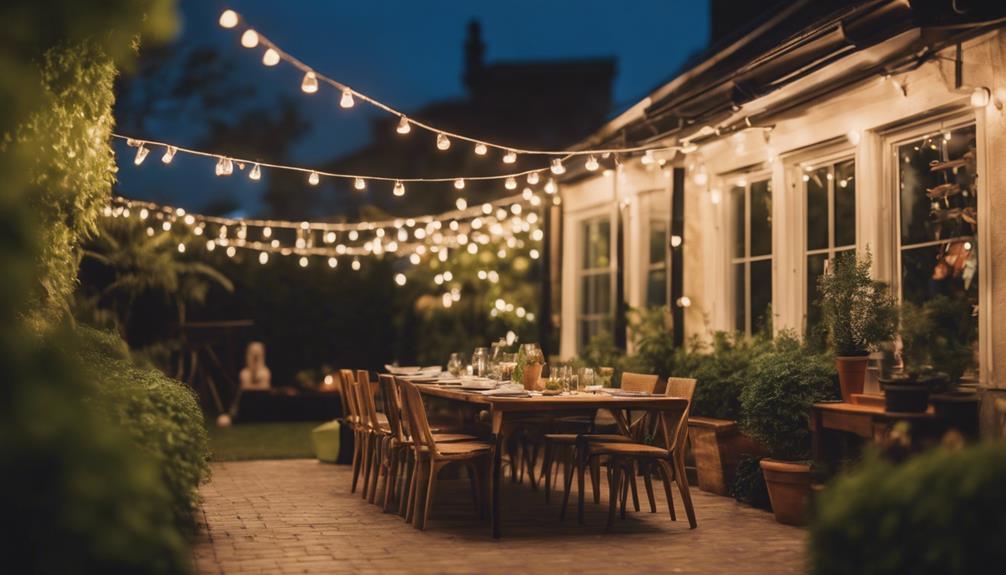
Dining alfresco means enjoying meals outdoors, typically in a restaurant's outdoor seating area. The term originates from Italian, signifying 'in the fresh air,' capturing the essence of dining outdoors in a natural setting. Embraced by various cultures, alfresco dining offers a connection with nature and a change from indoor dining, enhancing overall well-being with a soothing atmosphere. Choose a spot with a pleasant ambiance and scenic views, and enjoy popular dishes like BBQ and salads. Alfresco dining provides a unique experience, different from indoor settings, offering a relaxed and scenic atmosphere. Further exploration reveals cultural significance, benefits, and tips for a satisfying alfresco dining experience.
Key Takeaways
- Dining alfresco means enjoying meals outdoors in a restaurant's outdoor seating area.
- Originating from Italian, it signifies dining 'in the fresh air.'
- Offers a connection with nature, enhancing the dining experience.
- Provides a relaxed and casual ambiance for enjoying food.
- Popular for its invigorating and soothing outdoor atmosphere.
What Is the Definition of Alfresco?
When dining alfresco, you're enjoying your meal outdoors, typically in a restaurant's outdoor seating area or patio. The term 'alfresco' originates from Italian, signifying 'in the fresh air.'
This open-air dining experience allows you to relish your meal amidst nature, under the sky's expanse. While dining al fresco, you may benefit from the ambiance and natural surroundings that indoor dining can't replicate.
Some restaurants curate special menus or experiences for alfresco dining, elevating the outdoor dining affair. This third-party setup enables patrons to engage with their meal in a setting that transcends the traditional indoor dining atmosphere.
From casual picnics in the park to upscale dining on a scenic terrace or garden, alfresco dining caters to various preferences and occasions. So, when opting for alfresco dining, you immerse yourself in a unique culinary experience that seamlessly blends food with the beauty of the outdoors.
Origins and Meaning of Alfresco
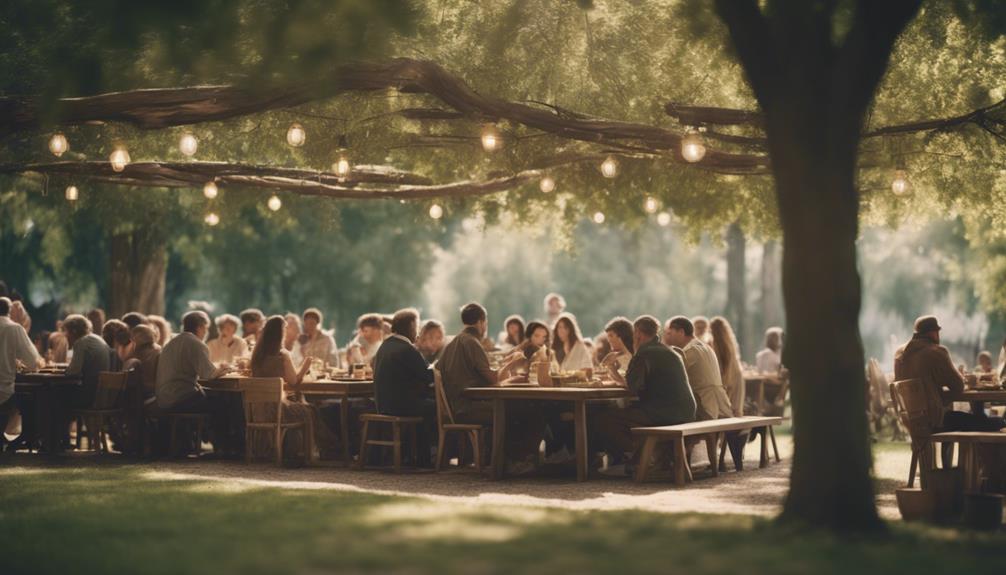
Originating from the Italian language, the term 'alfresco' embodies the concept of dining outdoors in the fresh air. The word 'alfresco' itself stems from the Italian words 'al' and 'fresco,' which translate to 'in the fresh air.' This term captures the essence of enjoying a meal outside, often in a natural setting.
Alfresco dining has gained popularity due to the invigorating experience it offers, allowing individuals to savor their meals while surrounded by the beauty of the outdoors. Whether it's a cozy picnic in the park or dining at a restaurant's outdoor terrace, alfresco dining provides an opportunity to connect with nature while enjoying delicious food.
Many establishments now provide alfresco dining options to cater to those who appreciate dining in open-air settings. This trend has been embraced by diners seeking a rejuvenating change from indoor dining, especially during the warmer months when the weather is conducive to outdoor meals.
Cultural Significance of Dining Alfresco
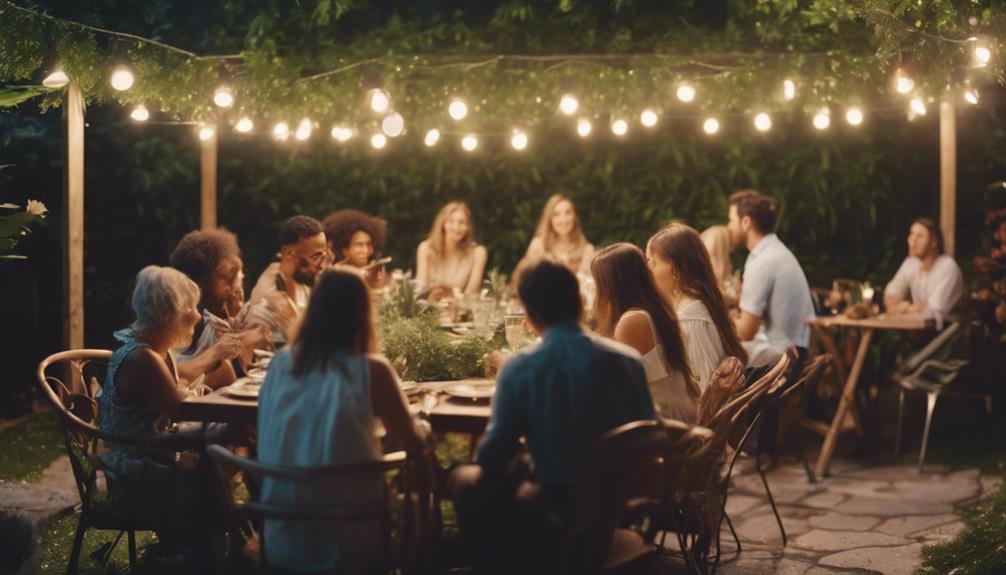
Frequently embraced across various cultures, dining alfresco holds a significant place in the world of culinary experiences. This outdoor dining tradition is cherished in many societies, particularly when the weather is warm and pleasant. The cultural significance of dining alfresco lies in its ability to foster a connection with nature and provide an invigorating change from indoor dining environments.
Breathing in the fresh air, basking in the natural surroundings, and savoring a meal under the open sky all contribute to a unique dining experience that transcends mere food consumption.
Moreover, dining alfresco offers a relaxed and casual ambiance that enhances the overall enjoyment of meals. Many people find that eating outdoors adds a touch of novelty and charm to their dining experience, making it more memorable and enjoyable.
It's no wonder that numerous restaurants around the world now offer alfresco dining options to cater to the preferences of customers who appreciate the allure of dining in the great outdoors.
Benefits of Eating Outdoors
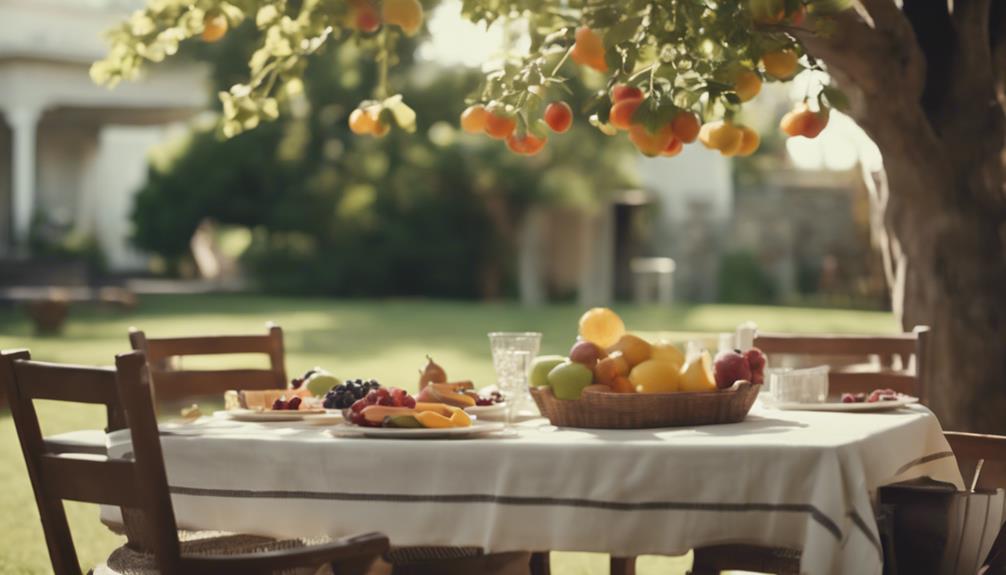
Eating outdoors offers a range of benefits that can enhance your dining experience and overall well-being. When you choose to dine alfresco, you open yourself up to a soothing and invigorating atmosphere that can rejuvenate your senses.
The opportunity to connect with nature and breathe in fresh air while enjoying your meal can elevate the dining experience beyond just the taste of the food. Many restaurants provide alfresco dining options, especially during warmer seasons, allowing customers to bask in the ambiance of the outdoors.
Whether you're gathering with friends and family, having a romantic date, or simply enjoying a casual meal, alfresco dining can offer a unique setting for your dining occasions.
Tips for Enjoying Alfresco Dining
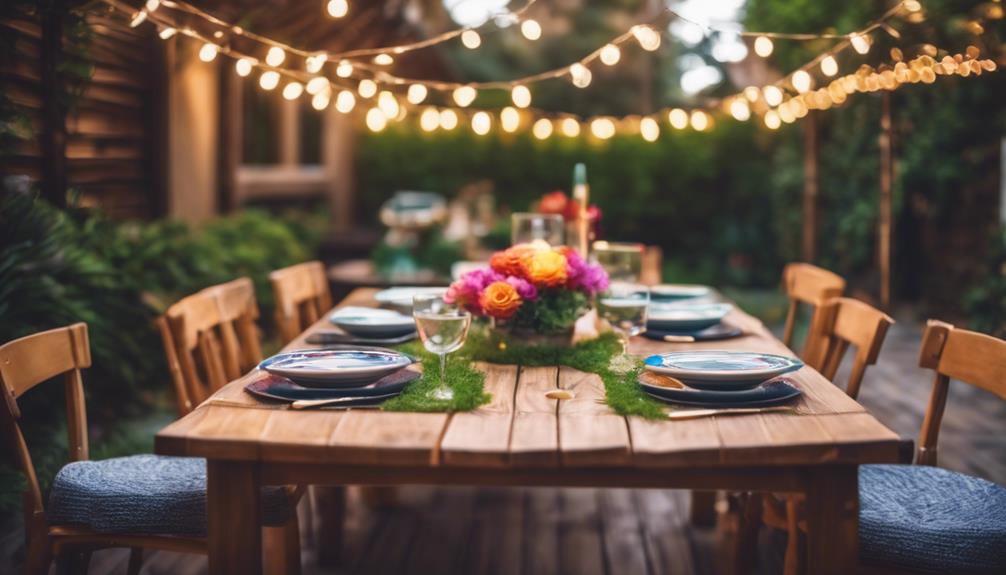
When indulging in alfresco dining, it's crucial to arrange your outdoor space thoughtfully to guarantee comfort and convenience. Selecting the right spot can improve your experience, offering a pleasant ambiance and maximum enjoyment of your meal.
Think about adding decorative elements to enhance the atmosphere and create a unique outdoor dining experience.
Setting up Outdoors
Looking to enhance your alfresco dining experience? Setting up outdoors is key to creating a cozy and enjoyable atmosphere for your meal. Consider bringing along picnic blankets or setting up a small table to place your dishes and drinks. Creating a comfortable outdoor space will allow you to relax and fully enjoy the open-air dining experience.
Restaurants often offer alfresco dining options, especially in warm weather, providing a pleasant setting for patrons to enjoy their meals outside. This allows for a more relaxed and casual dining experience, connecting diners with nature while savoring delicious food.
Popular dishes for alfresco dining include BBQ, salads, sandwiches, and invigorating beverages like lemonade or iced tea. These options are easy to enjoy outdoors and complement the relaxed atmosphere of dining alfresco.
Choosing the Right Spot
To fully enjoy alfresco dining, selecting the right spot is crucial for a pleasant experience. Here are some tips to help you choose the perfect location:
- Ambiance: Look for spots that offer a pleasant outdoor ambiance and good weather to enhance your dining experience.
- Shade: Opt for a shaded terrace or patio to avoid direct sunlight and guarantee you stay comfortable throughout your meal.
- Scenic Views: Consider locations with scenic views or a lively atmosphere to add to the enjoyment of your alfresco dining experience.
- Outdoor Seating: Choose restaurants or cafes with outdoor seating options to relish the fresh air and nature while dining.
Enhancing Ambiance With Decor
Enhance the ambiance of your alfresco dining experience by incorporating decorative elements such as string lights, candles, and cozy blankets. These additions can create a warm and inviting atmosphere for your outdoor meal.
Additionally, using outdoor-friendly tableware, like melamine plates and acrylic glasses, can enhance your enjoyment by providing practical and stylish options for dining al fresco.
To add a touch of nature to your setting, consider incorporating potted plants and flowers into your decor. These natural elements can bring a revitalizing and vibrant energy to your alfresco dining setup.
Moreover, setting up a portable speaker to play some background music can help elevate the mood and make your dining experience more enjoyable.
For cooler evenings, consider adding a fire pit or outdoor heater to keep you warm while dining outdoors. These practical additions can extend your alfresco dining season and ensure your comfort during chillier temperatures.
Alfresco Dining Around the World
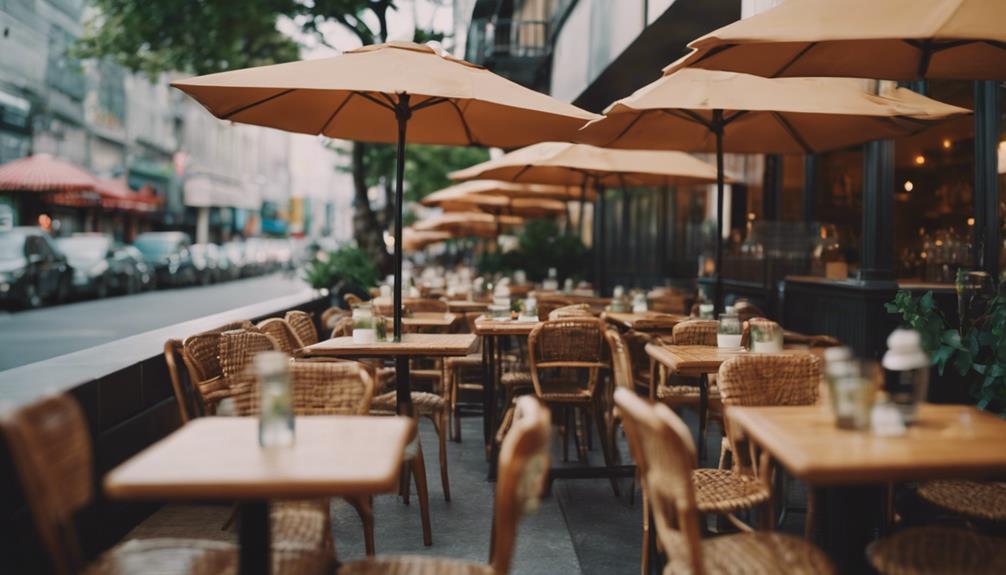
Alfresco dining can be experienced in various countries worldwide, offering diners a unique culinary experience in natural settings. Here are some examples of alfresco dining around the world:
- Italy: In Italy, you can savor traditional Italian dishes in charming piazzas or vineyard terraces, surrounded by picturesque landscapes.
- Thailand: Experience alfresco dining in Thailand, where you can enjoy spicy and flavorful Thai cuisine under the shade of palm trees on beautiful beaches.
- France: Indulge in exquisite French cuisine while dining al fresco in Parisian sidewalk cafes or quaint village squares, immersing yourself in the French culinary culture.
- Australia: Down under, relish fresh seafood and grilled delicacies in alfresco settings overlooking stunning ocean views or nestled in lush vineyards of the Australian countryside.
These destinations offer a diverse range of outdoor dining experiences, allowing you to enjoy delicious meals while appreciating the beauty of your surroundings.
Alfresco Vs. Indoor Dining Experience
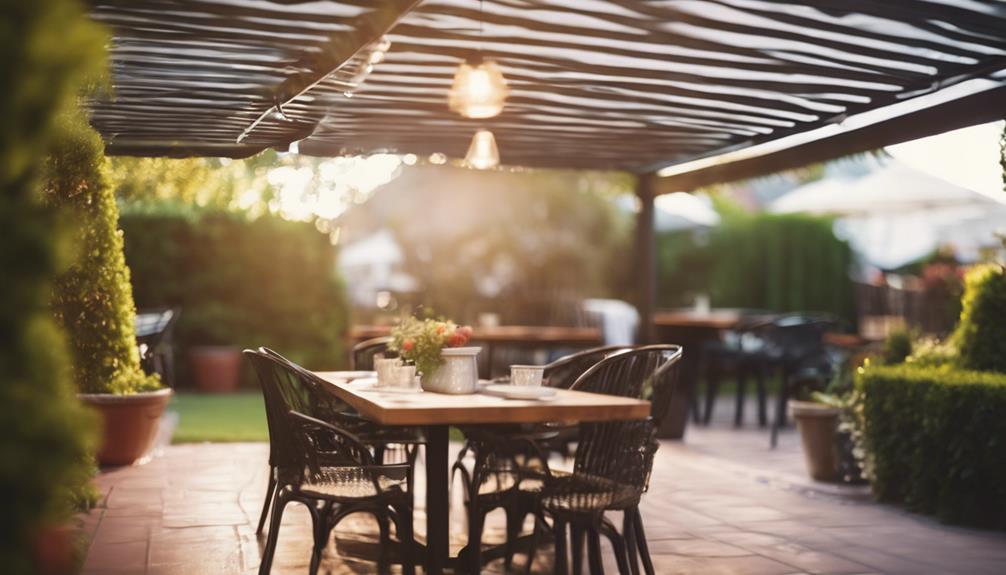
Experience the unique ambiance and differences between dining outdoors and dining indoors.
Dining alfresco offers a one-of-a-kind experience where patrons can enjoy their meals in the open air, surrounded by nature, fresh breezes, and natural light. The outdoor setting of alfresco dining can greatly enhance the overall dining experience, providing a more relaxed and scenic atmosphere compared to indoor dining. Many restaurants offer alfresco dining options, particularly during warmer months or in regions with favorable weather conditions. Alfresco dining can take various forms, including patio dining, rooftop dining, or picnics in outdoor spaces.
On the other hand, indoor dining offers a more controlled environment, shielded from external elements such as weather changes, insects, or noise disturbances. The indoor setting often provides a cozy and intimate atmosphere, ideal for formal dining experiences or during colder seasons. While indoor dining lacks the natural ambiance of alfresco settings, it offers a sense of comfort and privacy that some patrons may prefer.
Popular Alfresco Dining Destinations
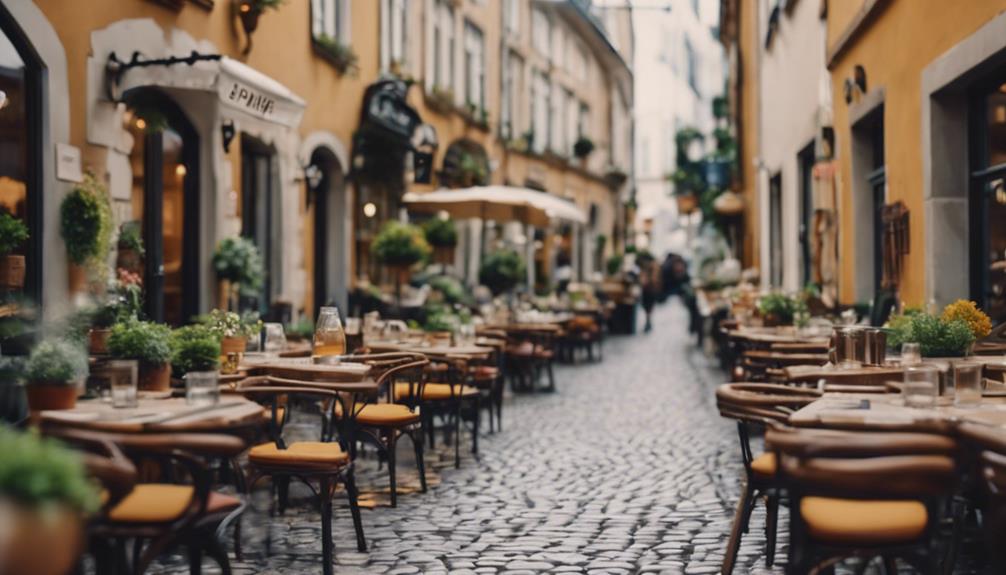
Discover picturesque locations around the world that are renowned for their popular alfresco dining options. When you seek to savor delectable dishes while basking in the open air, these destinations offer an exceptional experience.
Here are some remarkable places where alfresco dining thrives:
- Venice, Italy: Known for its charming canals and historic architecture, Venice provides a romantic backdrop for enjoying Italian cuisine under the stars.
- Positano, Italy: Nestled along the Amalfi Coast, Positano boasts cliffside restaurants with breathtaking views of the Mediterranean Sea, creating a truly enchanting dining ambiance.
- Tuscany, Italy: With its rolling hills, vineyards, and olive groves, Tuscany offers a serene setting for indulging in traditional Tuscan fare amidst nature's beauty.
- Santorini, Greece: The whitewashed buildings and stunning sunsets of Santorini make it a sought-after destination for alfresco dining, where you can sample Greek specialties while overlooking the Aegean Sea.
The Future of Dining Alfresco
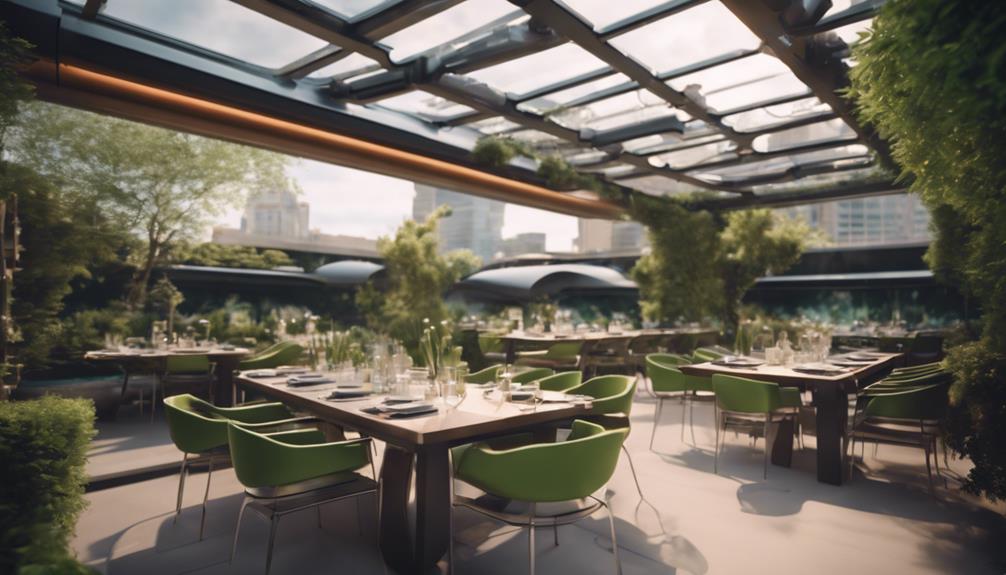
As outdoor dining continues to evolve, the future of enjoying meals under the open sky holds exciting possibilities for culinary enthusiasts worldwide. One of the trends shaping the future of alfresco dining is the integration of technology to enhance the overall experience. From digital menus accessible via QR codes to outdoor heaters controlled by smartphone apps, technology is revolutionizing how diners interact with their environment while dining outdoors.
Below is a table outlining some potential future developments in alfresco dining:
| Future Trends in Alfresco Dining | Description |
|---|---|
| Sustainable Practices | Increased focus on eco-friendly dining options |
| Virtual Reality Experiences | Immersive dining experiences through VR |
| Community Gardens | Restaurants growing their own produce on-site |
| Al Fresco Events | Outdoor food festivals and themed dining events |
| Smart Outdoor Dining Spaces | Integration of smart technology for comfort |
Frequently Asked Questions
What Does "Dining Al Fresco" Mean?
Dining alfresco means eating outdoors, like in a garden or patio. It's a special experience, letting you enjoy your meal in the fresh air. Many restaurants offer this option, making it great for various occasions.
What Does Al Fresco Mean in Slang?
When you hear 'al fresco' in slang, it symbolizes a laid-back vibe of dining outdoors. It's about embracing the fresh air and enjoying a casual meal outside. Many love this relaxed experience in warm weather or picturesque spots.
What Is Another Name for Alfresco Dining?
Alfresco dining, also known as 'open-air dining,' offers a special experience. You can enjoy your meal outdoors, soaking up the fresh air. It's a popular choice during warm weather, letting you savor your food in natural surroundings.
What Does Alfresco Mean Synonym?
Alfresco means dining outdoors or in the open air. You can enjoy your meal outside, savoring the fresh air and sunshine. It's a delightful experience, perfect for summer days or special occasions.
Conclusion
To sum up, dining alfresco offers a unique experience that allows individuals to connect with nature while enjoying a meal. Whether in a bustling city or a serene countryside, the benefits of eating outdoors are numerous.
So next time you have the chance, why not step outside and savor a meal under the open sky? After all, as the saying goes, 'A meal enjoyed in the fresh air is a feast for the senses.'
Alfresco
Is an Alfresco a Habitable Room? Understanding the Terms!
Find out if your alfresco can be considered a habitable room by understanding the essential terms and requirements for compliance with regulations.
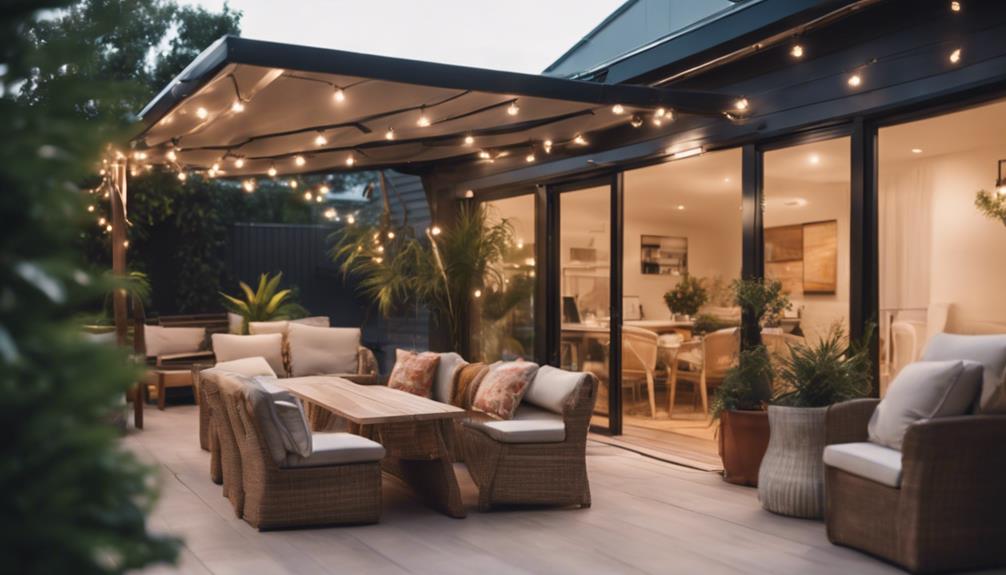
When considering if an alfresco qualifies as a habitable room, it must adhere to specific requirements. These include suitable space for living, proper ventilation, lighting, and compliance with the Building Code of Australia (BCA). Meeting these standards guarantees safe and comfortable living spaces within a building. Importantly, alfrescos may lack adequate heating and room size, hindering them from being habitable rooms. If you seek to convert an alfresco, consulting with local authorities and following BCA guidelines for essential permits is essential. Understanding these terms is important to guarantee compliance with regulations for a habitable living space.
Key Takeaways
- Alfrescos are not habitable rooms due to lack of heating and compliance with room size standards.
- Permanent heating installation is essential to meet habitable room criteria.
- Consultation with authorities is vital to determine if an alfresco can be converted into a habitable room.
- Compliance with BCA regulations and minimum ceiling height standards is necessary for alfresco conversions.
- Building permits are required for converting alfrescos into habitable rooms, ensuring safety and comfort.
Definition of Habitable Room
In building codes, a habitable room is defined as a space suitable for living, sleeping, eating, or cooking. To meet the standards of a habitable room, there are specific requirements such as minimum room size, proper ventilation, adequate lighting, and temperature control. These regulations guarantee that occupants have comfortable and safe living spaces within a building.
Examples of habitable rooms commonly found in a dwelling unit include bedrooms, living rooms, and kitchens. The designation of a room as habitable is essential for fulfilling the basic needs of individuals residing in a structure.
Compliance with the criteria set for habitable rooms plays a significant role in ensuring that the living environment is suitable for human occupancy. By adhering to these standards, building owners and occupants can be confident in the habitability and functionality of the living spaces provided within a property.
Building Permit Requirements
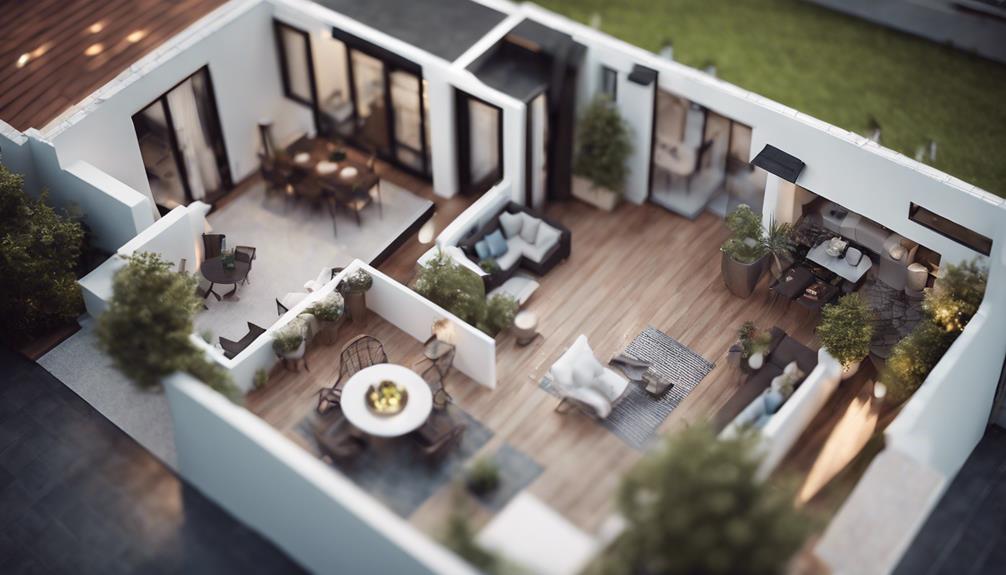
To convert an alfresco into a habitable room, you must adhere to strict building permit regulations. Essential compliance with the Building Code of Australia (BCA) is required when seeking a permit for this conversion.
Consider crucial aspects such as proximity to effluent systems and the necessity of a damp proofing membrane during the conversion process.
Permit Regulations Overview
For converting an alfresco into a habitable space, obtaining a building permit is an essential step that requires compliance with the Building Code of Australia (BCA).
When applying for a permit, it's vital to meet the minimum floor to ceiling height of 2.4m for habitable room conversions.
As part of the permit regulations overview, considerations such as proximity to effluent systems and damp proofing requirements must be addressed to guarantee the safety and livability of the space.
Required documents for a building application include a completed form, fees, design compliance certificate, site plan, and floor plan with elevations.
These documents are crucial for the permit process and demonstrate adherence to the necessary standards set by the BCA.
Compliance Checklist Essentials
How can you guarantee compliance with building permit requirements when converting your alfresco into a habitable room?
When converting your alfresco into a habitable room, it's important to ensure adherence to building permit requirements. This involves following the Building Code of Australia (BCA) and meeting specific criteria for habitable rooms.
Key considerations include the location of the alfresco in relation to effluent systems and the installation of damp-proofing membranes to prevent moisture issues. Additionally, habitable rooms must meet minimum floor to ceiling height requirements of 2.4 meters to ensure adequate livable space.
To ensure compliance, it's essential to submit the necessary documents as part of your building application. These documents may include design certificates, site plans, and floor plans detailing the proposed conversion of the alfresco into a habitable room.
Compliance With Building Code of Australia
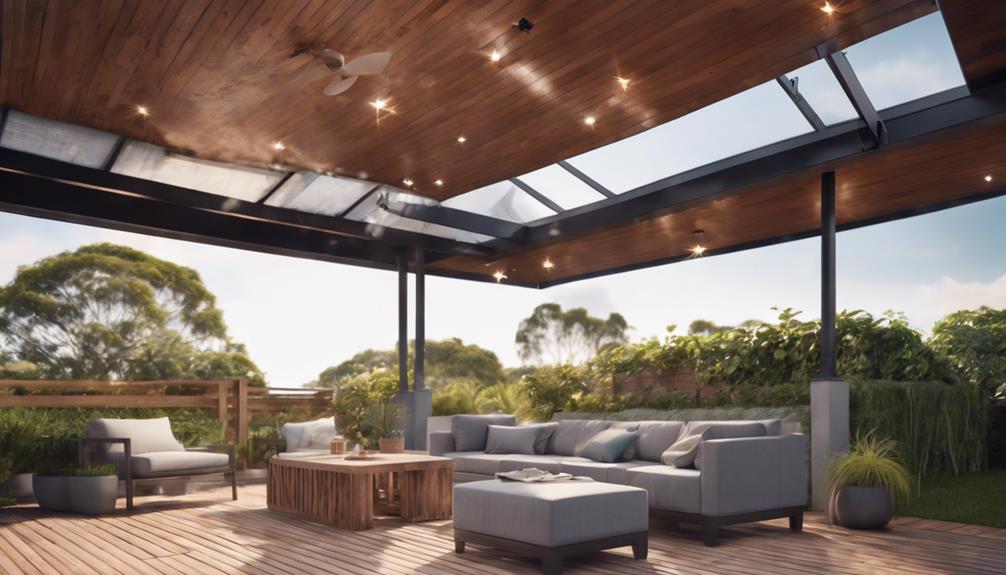
Ensuring compliance with the Building Code of Australia is vital in determining the habitability of an alfresco area. To be classified as a habitable space, alfresco areas must meet the specific BCA regulations set forth for such areas.
These regulations outline the requirements that alfresco areas need to fulfill in order to be considered habitable rooms. By adhering to the BCA guidelines, property owners can guarantee that their alfresco spaces meet the necessary standards for habitability.
Understanding and following BCA standards is essential as they dictate the specifications that alfresco areas must comply with to achieve the classification of habitable rooms. Therefore, when evaluating whether an alfresco area can be deemed habitable, it's imperative to assess its compliance with the Building Code of Australia to ensure that the space meets the required criteria for habitability.
Factors to Address for Conversion
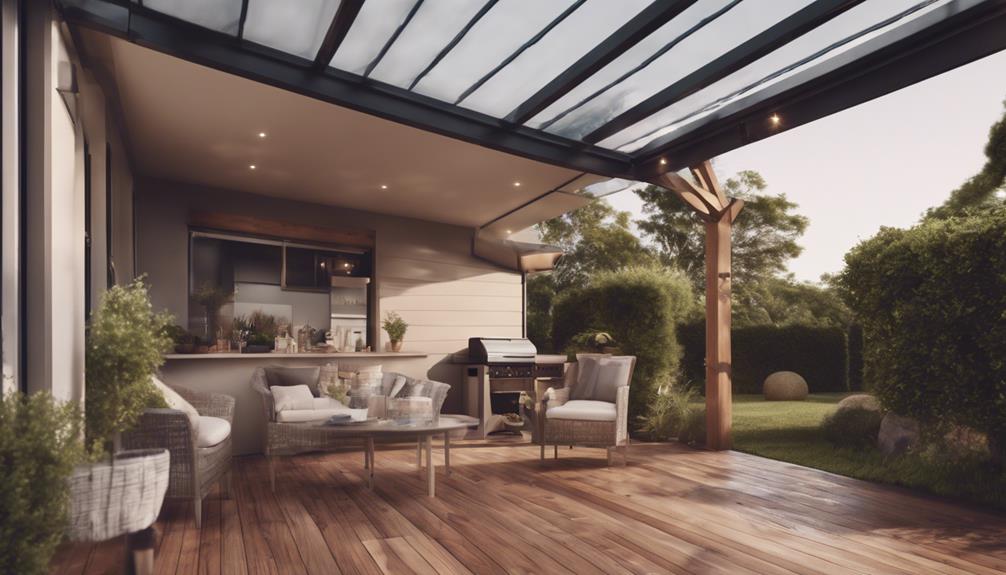
Consider key factors when aiming to convert an alfresco area into a habitable room. Alfrescos, typically outdoor recreational spaces lacking heating facilities, don't meet the requirements for habitable spaces as per building codes.
These areas aren't marketed as habitable by real estate agents. Merely adding portable heat sources doesn't transform alfrescos into habitable rooms, and even connection to the house's central heating system may not guarantee compliance with habitable space standards.
To convert an alfresco into a habitable room, addressing the heating deficiency is important. Installing a permanent heating system that adequately warms the space is essential to meet habitable room criteria.
It's important to note that the absence of proper heating remains a significant obstacle in reclassifying alfrescos as habitable areas. Therefore, ensuring a reliable heating solution is in place is a fundamental consideration when seeking to convert alfrescos into habitable rooms.
Minimum Ceiling Height Requirement
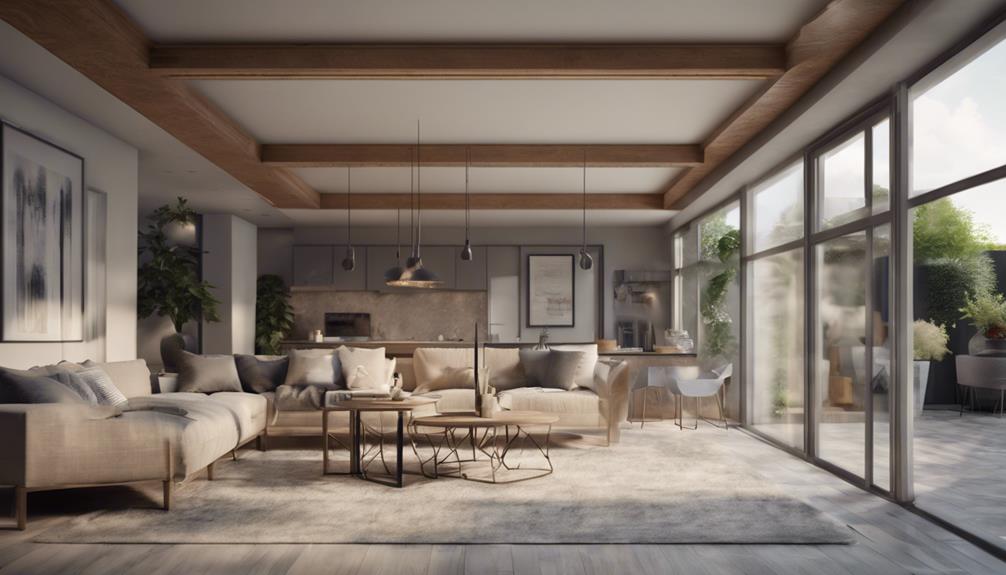
The minimum ceiling height requirement, typically set at 2.4 meters, plays a critical role in determining habitability. This standard guarantees that spaces are comfortable and functional for occupants while also complying with legal regulations.
Failing to meet these ceiling height standards can impact the usability and legality of a room or space.
Ceiling Height Standards
A habitable room must meet the minimum ceiling height requirement of typically 2.4 meters (7.87 feet) as mandated by building codes. The ceiling height standards are in place to guarantee that there's adequate headroom for comfortable use of habitable spaces.
It's important to comply with these minimum ceiling height standards as they play a significant role in designating a room as habitable. Proper ceiling height not only contributes to the overall habitability of a room but also affects its functionality.
Failure to meet these minimum requirements may have implications on the habitable status of a room. Hence, when designing or renovating a space, it's crucial to adhere to the established ceiling height standards to ensure that the room is both comfortable and functional for its intended use.
Comfort and Functionality
Meeting the minimum ceiling height requirement is essential for guaranteeing the comfort and functionality of habitable rooms. The standard height of 2.4 meters (7.87 feet) is established to provide adequate headroom and a sense of spaciousness within living areas. These dimensions contribute to a room's usability, allowing for the installation of lighting fixtures, ceiling fans, and other essential amenities without compromising comfort.
Natural light plays a key role in creating a welcoming atmosphere and can be maximized with proper ceiling height, enhancing the overall ambiance of the space. Additionally, adequate room sizes, combined with ideal ceiling height, ensure that furniture can be arranged effectively, promoting ease of movement and functionality.
While alfresco areas offer a unique outdoor experience for dining and entertainment, they don't adhere to habitable room standards due to their open nature and lack of enclosure. Therefore, compliance with minimum ceiling height requirements isn't expected for these outdoor spaces, as they serve a different purpose than traditional habitable rooms.
Legal Compliance Considerations
When considering legal compliance, ensuring that habitable rooms meet the minimum ceiling height requirement is vital for adherence to building regulations. The minimum ceiling height for habitable rooms, set at 2.4 meters (7.87 feet) by building codes, is essential to guarantee that the space is adequate for human occupancy.
This requirement applies to Alfresco areas as well; to be classified as habitable rooms, Alfresco spaces must also meet the 2.4-meter ceiling height standard. When submitting building applications for converting Alfresco areas, it's imperative to include detailed plans demonstrating compliance with the ceiling height requirement.
Failure to meet the minimum ceiling height could lead to non-compliance with building regulations concerning habitable spaces. Therefore, it's crucial to meticulously follow the stipulated ceiling height guidelines to ensure legal conformity and the safety and suitability of the living environment.
Consultation With Local Authorities

Engage local authorities early in the process to determine whether your alfresco area can be classified as a habitable room. By consulting with local authorities, you can guarantee compliance with regulations governing the habitability of alfresco spaces.
Here are three key reasons why involving local authorities is vital:
- Guidance on Regulations: Local authorities can provide clarity on whether your alfresco area meets the criteria set for habitable rooms in building codes, helping you understand the specific requirements that need to be met.
- Modification Advice: Authorities can advise on any necessary modifications or additions needed to classify your alfresco area as habitable, ensuring that it meets the standards set by the regulations.
- Compliance Assurance: Obtaining input from local authorities will help you navigate the complex regulations governing alfresco spaces, giving you confidence that your area complies with the necessary standards for habitable rooms.
Understanding Regulations and Approvals
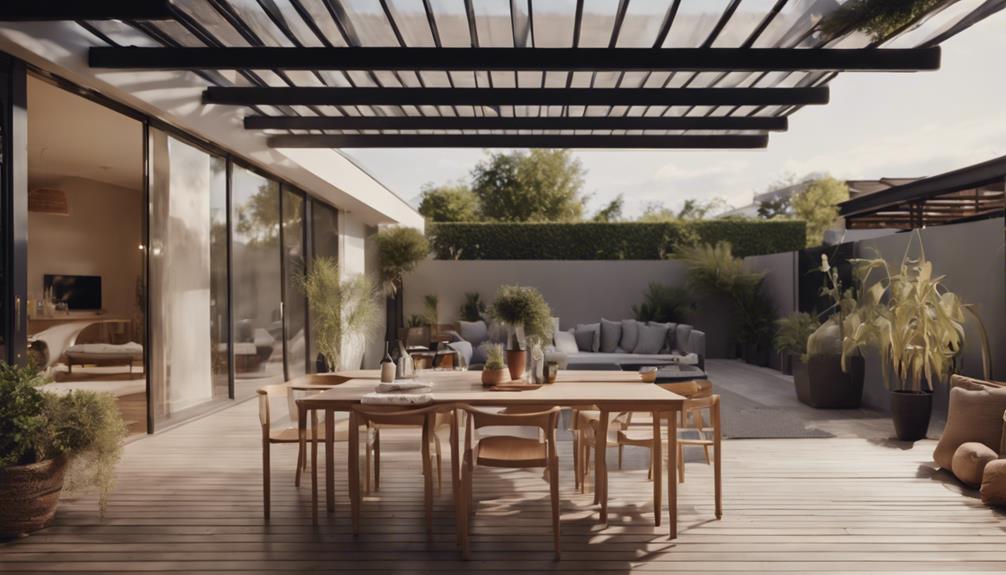
To guarantee adherence and successful conversion of your alfresco into a habitable room, understanding relevant regulations and obtaining necessary approvals is essential.
Building permits are a prerequisite for converting alfrescos into habitable rooms. Compliance with the Building Code of Australia (BCA) regulations is pivotal for ensuring a safe and habitable living space. Factors such as proximity to effluent systems and the installation of a damp proofing membrane are crucial considerations before initiating the conversion process.
A minimum floor to ceiling height of 2.4m must be met to classify alfrescos as habitable rooms. When applying for a building permit, make sure you have the required documents, including a completed form, design compliance certificate, site plan, and floor plan.
Remember that meeting these regulations and obtaining approvals are necessary steps in transforming your alfresco into a comfortable and legally compliant dwelling unit.
Frequently Asked Questions
What Is Considered a Habitable Room?
To be classified as habitable, a room must meet specific criteria like heating, lighting, ventilation, and insulation. Bedrooms, living rooms, studies, and recreation rooms are typical examples. Kitchens, bathrooms, and laundry rooms have their own requirements.
What Does Alfresco Mean in Housing?
Step into your outdoor oasis with an alfresco, a charming extension of your home. Alfrescos, though cozy, lack the essentials to be deemed habitable. Enjoy the fresh air and sun in this unique space!
What Is an Alfresco Room?
An alfresco room is an outdoor living space attached to a house, featuring outdoor furniture, cooking facilities, and entertainment areas. It provides a comfortable outdoor environment for dining and relaxation, popular for entertaining guests and enjoying the outdoors.
What Are Examples of Habitable Room?
Imagine cozy bedrooms, lively living rooms, productive studies, and fun recreation rooms. These are examples of habitable rooms where you relax, work, and play. They are designed for your comfort and daily activities.
Conclusion
To wrap up, while an alfresco area may provide a pleasant outdoor space, it doesn't meet the requirements to be classified as a habitable room. As the saying goes, 'a room is like a shell, it must offer shelter and comfort.'
It's important to understand the regulations and approvals needed before converting an alfresco into a habitable room to guarantee compliance with building codes and safety standards.
Always consult with local authorities for guidance on these matters.
Alfresco
Is Alfresco Leather Real Leather? Discover the Truth!
Get ready to uncover the truth about Alfresco leather, a luxurious and authentic choice that redefines the essence of real leather.

Yes, Alfresco leather is indeed real leather, characterized by its exceptional softness, durability, natural markings, grainy texture, and unique aroma. This premium quality leather choice stands out due to its authentic feel and distinctive features. Genuine Alfresco leather showcases warmth, fat wrinkles, and imperfections that affirm its authenticity. The sensory experience of its rich scent and luxurious touch further confirms its premium quality. Understanding the distinct characteristics of real leather, like Alfresco leather, underscores its excellence and sophistication in the world of leather products, ensuring a high standard of quality and performance.
Key Takeaways
- Alfresco leather is a genuine type of real leather.
- Its authenticity is confirmed by natural markings, texture, and unique aroma.
- Characteristics like warmth, fat wrinkles, and imperfections distinguish it from synthetics.
- Genuine Alfresco leather exhibits exceptional durability and softness.
- Sensory cues such as a rich natural scent and luxurious touch validate its premium quality.
Characteristics of Real Leather
Real leather, including Alfresco leather, boasts distinct characteristics that set it apart from synthetic materials. Let's take a look.
Alfresco leather is renowned for its exceptional softness and durability, making it a preferred choice for luxury furniture pieces like sofas. Genuine Alfresco leather can be identified by its natural markings, grainy texture, and unique aroma. When you touch Alfresco leather, it should feel warm and exhibit fat wrinkles, along with imperfections such as uneven edges, showcasing its authenticity.
Moreover, an essential aspect of determining genuine Alfresco leather is the sensory experience. When tested, authentic Alfresco leather will emit a rich, natural scent and offer a luxurious, supple feel to the touch. These sensory cues, combined with the visual indicators of natural markings and texture, confirm the premium quality of Alfresco leather.
As a high-quality material, Alfresco leather exemplifies the excellence and sophistication associated with genuine leather products.
Identifying Genuine Leather

To determine if leather is genuine, examine its natural hide markings, texture, and aroma to distinguish it from synthetic materials.
When identifying genuine leather like Alfresco leather, pay attention to the following:
- Look for rough or uneven edges: Genuine leather often has imperfections that synthetic materials lack, such as uneven edges or fat wrinkles.
- Check for diverse pores: Real leather will have a varying pattern of pores on the surface, unlike faux leather, which may have a consistent and uniform pore pattern.
- Feel for a warmer touch: Authentic leather tends to feel warmer to the touch compared to synthetic alternatives, which can sometimes feel colder or artificial.
Types of Leather Grades

When exploring types of leather grades, understanding the distinctions between various categories can guide your selection of the most suitable leather for your needs. Leather grades are typically categorized into several main groups, each offering different qualities and characteristics. Below is a table outlining common leather grades:
| Leather Grade | Description |
|---|---|
| Full Grain | Highest quality, natural appearance, and durability |
| Top Grain | Sanded and refined, maintains quality with a bit of processing |
| Genuine | Made from real leather but with lower quality and durability |
| Bonded | Made from scraps of leather bonded together with adhesives |
| Faux Leather | Synthetic material designed to mimic real leather |
Each leather grade serves a distinct purpose, with full grain being the top choice for its premium quality and natural appearance. Understanding the differences between these grades can assist you in selecting the ideal leather type for your specific requirements.
Choosing Quality Leather

Exploring quality leather options involves considering factors like material composition, durability, and maintenance requirements to guarantee the ideal choice for your needs. When faced with the decision between Alfresco leather and genuine leather, it's important to delve into the specifics to make an informed choice.
Here are three key points to guide you in selecting quality leather:
- Material Composition: Alfresco leather, a synthetic blend of polyester and polyurethane, offers durability and ease of cleaning. Genuine leather, on the other hand, boasts natural characteristics and a unique aging process that contributes to its appeal.
- Durability: Genuine leather tends to be more robust and ages beautifully, developing a rich patina over time. In contrast, Alfresco leather provides a durable alternative that's resistant to stains and fading, ideal for those seeking longevity without the intricate aging of real leather.
- Maintenance Requirements: Genuine leather may require more care and conditioning to maintain its quality, while Alfresco leather offers a low-maintenance option that's easy to clean and upkeep.
Caring for Real Leather

Regularly cleaning your Alfresco real leather with a damp cloth helps remove dust and dirt, maintaining its appearance and longevity.
To guarantee your real leather stays in top condition, it's crucial to use a leather conditioner specifically formulated for real leather. This step will help keep the leather moisturized and supple, preventing it from drying out and cracking over time.
Additionally, avoid exposing your Alfresco real leather to direct sunlight for extended periods to prevent fading and drying of the material.
In case of spills, make sure to clean them up immediately to prevent stains and damage to the leather surface.
Finally, to promote even wear and maintain the overall appearance of your real leather sofa, remember to rotate the cushions regularly.
Frequently Asked Questions
How to Know if Leather Is Real or Fake?
To determine if leather is real or fake, inspect for natural imperfections like fat wrinkles, conduct a burn test for a burnt hair smell, and sniff for a genuine aroma. Avoid bi-cast leather, which lacks durability.
What Is the Most Authentic Leather?
When seeking the most authentic leather, opt for Full Grain leather. Its durability, natural imperfections, and ability to develop a unique patina over time set it apart. Embrace its luxurious feel and timeless elegance.
How Do I Tell if My Couch Is Real Leather?
To tell if your couch is real leather, look for natural hide markings, a rich, natural smell, and diverse pores. Check for imperfections, a soft touch, and variations in color or texture. Perform a burn test or check the label for confirmation.
What Is the Most Durable Leather for a Recliner?
So, you're pondering the most durable leather for a recliner. Opt for Full Grain leather, it's the champ – boasting natural imperfections that age like fine wine. Skip Bonded leather, it's as flimsy as a house of cards.
Conclusion
To sum up, only authentic leather possesses the unique characteristics that make it a durable and luxurious material. According to a recent study by the Leather Working Group, 86% of consumers prefer real leather products for their quality and longevity.
So, when considering purchasing alfresco leather or any other leather product, remember to look for the telltale signs of authenticity to make sure you're getting the real deal.
Alfresco
Is Alfresco Kuching Halal? Find Out Now!
Perplexed about Alfresco Kuching's halal status? Uncover the meticulous sourcing practices and dining experience ambiance to discern if it aligns with your dietary preferences.
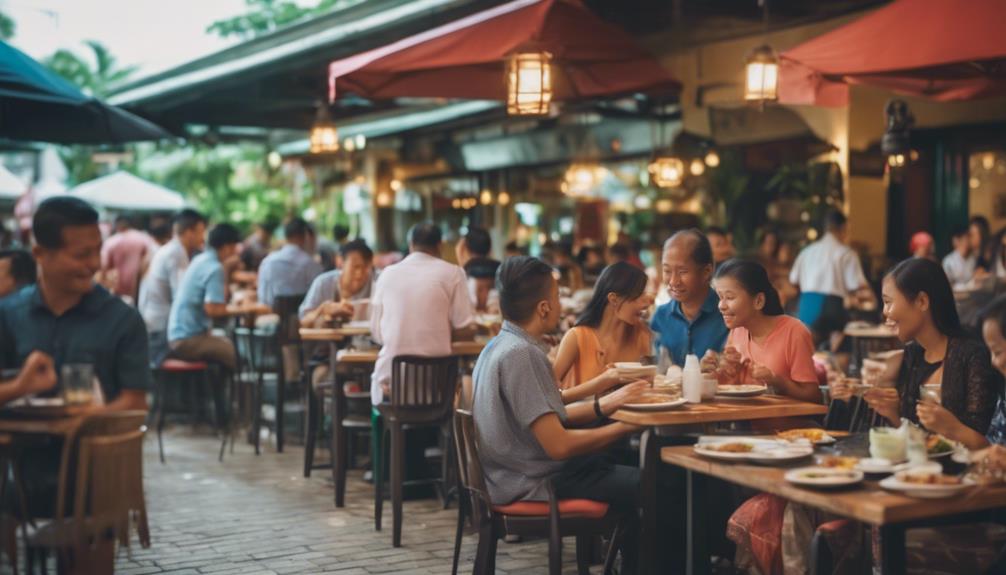
When considering the halal status of Alfresco Kuching, it's important to note that this establishment lacks halal certification. Despite this, they meticulously source their ingredients ethically from suppliers possessing halal certification, ensuring alignment with strict Islamic dietary laws. The absence of official halal endorsement warrants direct inquiry regarding specific dishes and preparation methods. Positive reviews commend their pleasant atmosphere and location, enhancing the dining experience. For precise verification on halal options, confirming practices with the restaurant directly or seeking insight from local halal authorities is recommended. Further details are available to deepen your understanding of Alfresco Kuching's stance.
Key Takeaways
- Alfresco Kuching offers non-halal food items alongside Malaysian and fusion cuisines.
- Ingredients are ethically sourced from suppliers holding halal certification.
- Stringent adherence to halal standards and requirements in food preparation.
- Halal certification process is meticulous to ensure compliance with Islamic dietary laws.
- Recommended to contact Alfresco Kuching directly for precise information on halal options.
Overview of Alfresco Kuching's Menu
With a diverse array of dishes to choose from, Alfresco Kuching's menu caters to various tastes and dietary preferences. The menu at Alfresco Kuching is carefully crafted, showcasing a good design that appeals to customers seeking a delightful dining experience.
Drawing from different sources of inspiration, the menu offers a great choice of Malaysian favorites like Laksa and Kolo Mee, as well as a blend of Asian and Western cuisines to cater to a wide range of palates.
Each dish on the menu is prepared using high-quality ingredients to guarantee a satisfying culinary experience for patrons. The menu not only provides an extensive selection of dishes but also aims to create a memorable dining experience for customers in a cozy and inviting atmosphere.
Whether you're a meat lover or a vegetarian, Alfresco Kuching's menu offers something to suit everyone's preferences, making it a versatile dining destination for those looking to enjoy a mix of flavors in a well-designed setting.
Halal Certification of Alfresco Kuching
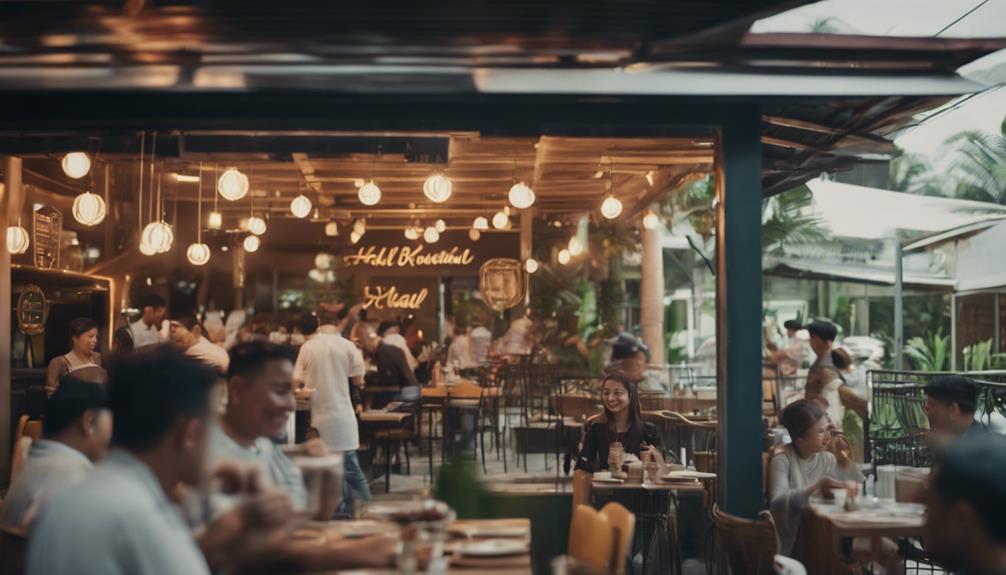
Alfresco Kuching doesn't hold a halal certification, offering non-halal food items on its menu instead. While the restaurant caters to various dietary preferences, including non-halal options, individuals seeking halal meals should be aware of this status.
It's important for visitors looking for halal choices to explore other dining establishments in Kuching that have obtained halal certification. Checking the certification status of restaurants before dining is advisable to guarantee adherence to halal requirements.
Alfresco Kuching's current offerings don't align with halal standards, making it essential for those following halal guidelines to seek alternative dining options in the area. As the restaurant serves non-halal food items, individuals prioritizing halal meals should exercise caution when dining at Alfresco Kuching.
Ingredients Sourcing Practices

Alfresco Kuching maintains a commitment to ethical ingredient sourcing, ensuring all suppliers hold halal certification to adhere to strict halal standards.
By prioritizing transparency in their sourcing practices, the restaurant upholds the integrity and authenticity of its halal ingredients, reflecting its dedication to meeting the halal dietary requirements of its clientele.
The halal certification process at Alfresco Kuching underscores the meticulous attention to detail in ingredient selection, guaranteeing a genuine halal dining experience for all patrons.
Ethical Ingredient Sourcing
How does Alfresco Kuching guarantee ethical sourcing practices for its ingredients?
Alfresco Kuching secures ethical ingredient sourcing by adhering to strict standards that align with Halal requirements. The restaurant places a high priority on sourcing Halal ingredients to meet the dietary needs of Muslim patrons.
Transparency is maintained throughout the ingredient sourcing process, emphasizing the importance of ethical practices. The commitment to sourcing ethically aligns with the Halal dietary regulations, ensuring that all ingredients used meet the necessary criteria.
Halal Certification Process
The Halal certification process at Alfresco Kuching meticulously verifies the adherence of ingredient sourcing practices to strict standards. This process guarantees that all ingredients used in the restaurant's dishes are sourced from halal-certified suppliers. By following stringent halal certification procedures, Alfresco Kuching assures that the food served aligns with Islamic dietary laws. Emphasizing the importance of sourcing practices, the restaurant aims to provide customers with complete confidence in the halal compliance of their meals.
Through this meticulous certification process, Alfresco Kuching upholds its commitment to offering halal-compliant food options. Customers can trust that the ingredients used in their dining experience meet the necessary standards for halal preparation. This dedication to sourcing practices reflects the restaurant's unwavering assurance to deliver meals that adhere to Islamic dietary requirements.
Dining at Alfresco Kuching not only promises a flavorful experience but also a halal-conscious one, where ingredient integrity is at the forefront of culinary excellence.
Transparency in Sourcing
Promoting transparency in sourcing practices, Alfresco Kuching prioritizes the origin and quality of its halal ingredients. The restaurant places a strong emphasis on sourcing high-quality halal ingredients and is dedicated to providing clear information regarding the origin of the food items used in their dishes.
Customers have the option to inquire about the specific sourcing of ingredients, reflecting Alfresco Kuching's commitment to openness in their ingredient procurement process. Additionally, the restaurant's transparency extends beyond just the customers; it also encompasses their relationships with ingredient suppliers and the certifications related to their sourcing practices.
Dietary Restrictions Considerations

When considering dietary restrictions at Alfresco Kuching, it's vital to understand the importance of halal certification and menu labeling clarity.
Ensuring that the food aligns with your requirements is essential for a comfortable dining experience. It's advisable to seek clarification from the restaurant staff regarding the preparation and sourcing of each dish to make informed decisions.
Halal Certification Importance
For Muslim consumers, the significance of Halal certification lies in guaranteeing compliance with Islamic dietary laws when dining out. Halal certification serves as an assurance that the food prepared and served at a restaurant aligns with the guidelines set forth in Islam.
In Malaysia, where Halal certification is rigorously enforced, restaurants must adhere to strict protocols in food preparation and ingredient sourcing to maintain their certification. The presence of a valid Halal certification not only signifies adherence to religious requirements but also plays a significant role in shaping a restaurant's reputation among Muslim diners.
When making dining decisions, consumers actively seek out visible Halal certification logos or certificates displayed by establishments. Therefore, for individuals looking to dine at Alfresco Kuching, verifying the restaurant's Halal status through official certification from recognized authorities is essential to comply with their dietary restrictions and beliefs.
Menu Labeling Clarity
Alfresco Kuching's clear menu labeling of halal options caters to customers with dietary restrictions, providing detailed information for Muslim patrons. The restaurant ensures transparency in menu labeling, allowing guests to easily identify halal-certified dishes. This clarity aids in accommodating individuals with specific dietary needs, enabling them to make informed choices based on their preferences. By prominently displaying halal menu items, Alfresco Kuching creates a seamless dining experience for those adhering to halal dietary practices. The commitment to clarity in menu labeling underscores the restaurant's dedication to serving diverse customer requirements.
| Menu Labeling Clarity at Alfresco Kuching |
|---|
| 1. Clear indication of halal options |
| 2. Detailed information for Muslim patrons |
| 3. Transparency for dietary restriction needs |
Customer Reviews and Feedback

Highlighting the diverse range of dishes available, customer reviews for Alfresco Kuching commend the dining experience for its cleanliness and atmosphere.
Patrons have expressed satisfaction with the hygienic standards maintained at the restaurant, emphasizing the pleasant ambiance that enhances their dining pleasure. Feedback often includes helpful tips for first-time visitors, ensuring a smooth and enjoyable experience for all guests.
Many customers also appreciate the convenient location of Alfresco Kuching, making it a go-to choice for locals and tourists alike. Overall, reviews indicate a positive reception towards the dining experience offered at the restaurant.
One reviewer remarked, 'The cleanliness at Alfresco Kuching is exceptional, and the atmosphere adds to the overall enjoyment of the meal.' Such sentiments from satisfied customers contribute to the restaurant's reputation for providing a welcoming and enjoyable dining environment.
Final Verdict: Is Alfresco Kuching Halal?
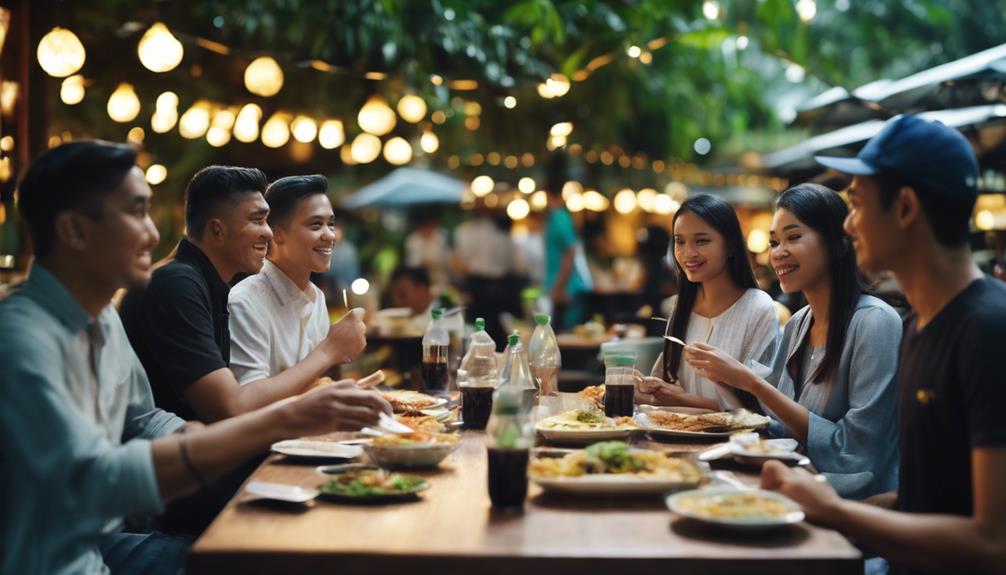
Moving from customer reviews to the important topic of the halal status, it's advisable to directly inquire with Alfresco Kuching regarding their certification. It's essential to confirm that the restaurant meets your halal requirements. By contacting them, you can get accurate information about their ingredients and preparation methods.
Verifying the certification or practices of the dining establishment is vital for those seeking halal options. If you're uncertain about the halal status of a restaurant, consulting with local halal authorities or organizations can offer clarity.
Frequently Asked Questions
Is Alfresco Kuching a Pork-Free Establishment?
If you're curious about Alfresco Kuching being pork-free, you'll be pleased to know that it is! They guarantee a pork-free environment for all diners, so you can enjoy your meal without any worries.
Are There Vegetarian Options Available at Alfresco Kuching?
Yes, there are vegetarian options available at Alfresco Kuching. You can enjoy a variety of meat-free dishes that cater to your dietary preferences, ensuring you have a delicious dining experience at the restaurant.
Does Alfresco Kuching Offer Delivery Services?
Offering delivery to over 90% of Kuching, Alfresco Kuching provides convenient services for those craving their delicious meals. You can enjoy their food from the comfort of your home with just a few clicks.
What Are the Operating Hours of Alfresco Kuching?
Alfresco Kuching's operating hours are from 11:00 AM to 10:00 PM. You can enjoy their delicious dishes during this time. Plan your visit accordingly to savor their offerings at your convenience.
Can I Make Reservations at Alfresco Kuching?
You can make reservations at Alfresco Kuching by calling ahead. They offer this service to guarantee you have a table ready upon arrival. Contact them to secure your spot in advance.
Conclusion
To sum up, Alfresco Kuching has undergone a thorough halal certification process, ensuring that all menu items adhere to Islamic dietary guidelines. With a commitment to sourcing quality halal ingredients and accommodating various dietary restrictions, customers can dine with confidence at Alfresco Kuching.
As one satisfied patron remarked, 'Eating at Alfresco Kuching is like enjoying a delicious meal with peace of mind, knowing that every bite is halal-certified.'
So, for those seeking a halal dining experience in Kuching, Alfresco Kuching is a recommended choice.
-

 Craft and Textiles2 months ago
Craft and Textiles2 months ago15 Best Places to Buy Appliances for Your Home – Top Retailers Reviewed
-

 Decorative Throws2 months ago
Decorative Throws2 months agoIs It Better to Dry Clean Blankets?
-

 Vetted3 weeks ago
Vetted3 weeks ago14 Best Personalized Father's Day Gifts for Your Husband – Show Him You Care
-

 Yarn2 months ago
Yarn2 months agoIs Yarn Natural or Manmade? Unravel the Truth
-

 Tableware and Dining Accessories2 months ago
Tableware and Dining Accessories2 months agoWhat Is the Meaning of the Word Tableware
-

 Tableware and Dining Accessories2 months ago
Tableware and Dining Accessories2 months agoWhat Is the Hindi Meaning of Tableware
-

 Craft and Textiles2 months ago
Craft and Textiles2 months ago15 Best Cordless Mowers for Effortless Lawn Care – Top Picks of 2024
-

 Craft and Textiles2 months ago
Craft and Textiles2 months ago15 Best Battery-Powered Leaf Blowers for Effortless Yard Work


















